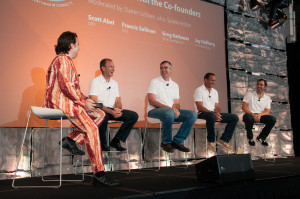By AMY MCCULLOUGH
Reporter with Silicon hills News

(L-R) Bacon suit-clad Spiceworks IT pro Darren Schoen interviews Spiceworks co-founders, CEO Scott Abel, CTO Francis Sullivan, VP of Development Greg Kattawar, and VP of Marketing Jay Hallberg at SpiceWorld Austin 2012.
In 2005, four IT industry friends met at an Austin Starbucks to brainstorm a way for them to work together, have fun, and find a solution for common needs of system administrators. Scott Abel, Jay Hallberg, Greg Kattawar, and Francis Sullivan envisioned the social way to do IT: a free platform where IT professionals could connect with each other, learn about available technology solutions, and work more efficiently. These conversations led to the birth of
Spiceworks in July 2006.
By the end of its first year, Spiceworks had 32,000 users. Now, about 5 million IT pros use the Spiceworks system to manage their help desks, networks, onsite software and offsite cloud services. These users—who influence or control more than $500 billion in annual spend on IT services and products—come to Spiceworks to get unbiased, user-written product reviews of the more than 3,000 technology brands that advertise on the platform.
Spiceworks’ popularity has inspired Goldman Sachs to invest $57 million, which CEO Scott Abel said will be used to ramp up efforts for a new Spiceworks’ goal: creating an app store for the IT industry.
“We were already going down the path (of creating an IT app store), but it was going too slow. A chunk of this new money will go to accelerate the effort of the development of the platform for that app store, as well as for marketing to get the word out and let developers know this is an incredible platform where they can reach 5 million IT pros and not only build products but also sell them and make money,” Abel said.
David Campbell, managing director in Goldman Sachs’ Merchant Banking Division, will join Spiceworks’ board of directors.
“The emergence of professional networks like Spiceworks represents the next wave of social innovation,” Campbell said in a statement. “Spiceworks has a unique platform for technology brands to directly access a rapidly-growing, critical, and underserved market of IT professionals that commands over $525 billion of spend today.”
Spiceworks’ funding began with Austin Ventures. More support followed from Austin Ventures and Shasta Ventures, then Institutional Venture Partners, Adams Street Partners, and Tenaya Capital, for a total of $55 million, prior to the Goldman Sachs investment.
The Spiceworks “spice”
Abel expects the company to add about 100 employees this year, which will bring Spiceworks’ count to 340 by year end. An upcoming challenge will be maintaining the company’s unique culture.
“We started this company for the four of us (founders) to start having fun again, and most of that revolved around how people behaved from day to day. One of the biggest challenges for me is how do we maintain the unique culture we have, given how fast we’re growing,” Abel said.
New employees start off with a program called Jump Start, where they interface with the company founders. A company goal is transparency and accessibility, Abel said.
Spiceworks’ users are uniquely enthusiastic. Many IT pros chat in the online community about some of their favorite food topics, like bacon and chili. Some have even gone so far as to tattoo the company’s mascot, an orange dinosaur called SpiceRex, on their bodies.
Houston-based infrastructure administrator Nigel Hickey appreciates the accessibility of the Spiceworks team of which he feels “like part of the family.” A former DJ, Hickey recently played music at the SpiceWorld conference in Austin.
Hickey, who is responsible for the computers of almost 100 employees and 10 servers in four different office locations at National Specialty Alloys, said he “looked like a champion” two years ago when he began using the Spiceworks help desk system.
When he arrived at his company, no help desk system was in place, and executives were consistently being interrupted with computer issues. Hickey was able to set up a Spiceworks ticketing system in four days. Now, when employees send e-mails to the company help desk, Spiceworks picks them up, converts them into tickets, and puts them in a queue. The system also shows which tickets are assigned to which employees.
From a marketing perspective, Katie Drucker, a vendor representative for South Carolina-based Unitrends, said her company is very happy with its investment in the Spiceworks community.
With any kind of shopping, Drucker said, the best research often comes from asking a friend’s opinion. The Spiceworks community offers IT pros a wealth of product reviews from users and access to information from vendors like Unitrends, a seller of appliance-based backup solutions.
Drucker is Unitrends’ “green gal,” or vendor representative, in Spiceworks. (Spiceworks users are color-coded: Vendors are green, IT pro users are blue, and Spiceworks’ employees’ are orange.) She spends about 75 percent of her work time interfacing with the Spiceworks community.
Although she can’t release numbers, Drucker said Unitrends’ spend in Spiceworks has a significant positive impact on the company’s sales. “We have really enjoyed being part of the community. It gives us great way to interact with our target market … and not only talk to people who are considering a new backup solution, but also help people who are currently using our backup solution at Unitrends.”
Unitrends has tried different advertising strategies in Spiceworks, including banner ads, e-mails and a live stream, Additionally, Unitrends has attended four different SpiceWorld events in Austin and London and are booked to do them again this year.
“We get what we give. By spending time in the community and helping people troubleshoot their issues … we’ve been able to gain a lot of friends and fans,” Drucker said.
